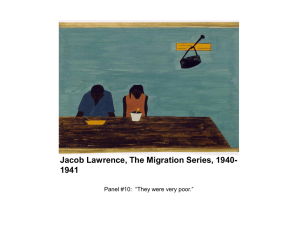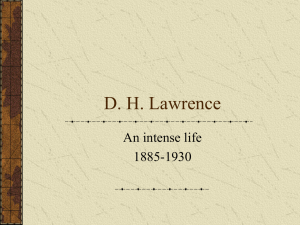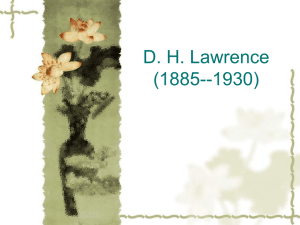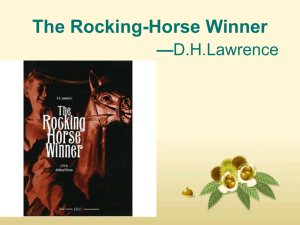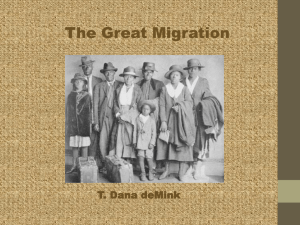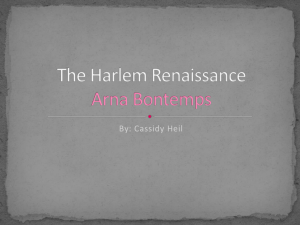Jacob Lawrence Migration Series - Humanities – Picturing America
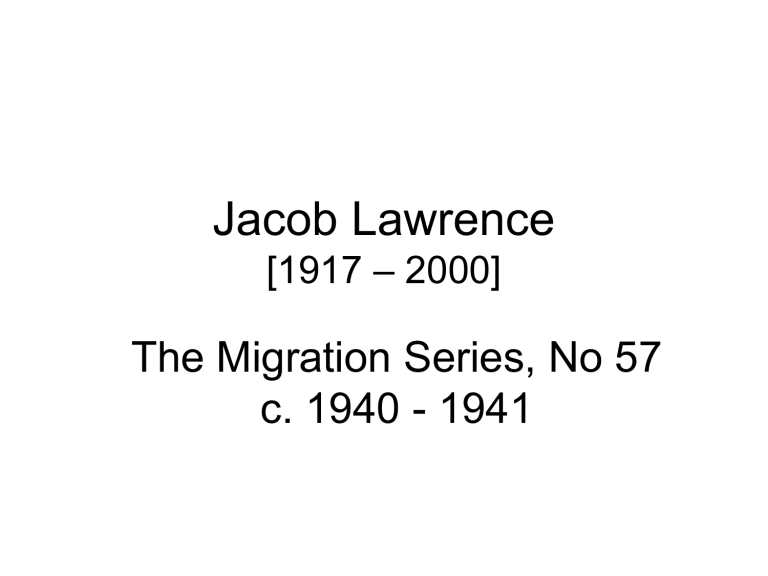
Jacob Lawrence
[1917 – 2000]
The Migration Series, No 57 c. 1940 - 1941
Jacob Lawrence is regarded as one of the masters of African-American art.
• Lawrence was born in Atlantic City, New
Jersey.
• When his parents separated, Lawrence and his siblings moved with their mother first to Pennsylvania and eventually to
Harlem.
• To keep her young son busy, Rose
Lawrence enrolled young Jacob in art classes, where he showed early promise.
Jacob Lawrence age 6
• Both she and the artist’s father had
“come up”— a phrase used to indicate one of the most important events in African
American history since Reconstruction:
• The migration of African Americans out of the rural South.
• This exodus was gathering strength at the time of World War I, and fundamentally altered the ethnic mix of New York City and great industrial centers such as
Chicago, Detroit, Cleveland, and
Pittsburgh.
• In the late 1930s, the American artist
Jacob Lawrence began producing extended narratives composed of multiple small paintings that were based on history or biography.
• Lawrence started "The Migration of the
Negro" -- that's the complete original title of his series -- in 1940, when he was 22.
• He was born in New Jersey to parents who'd recently left the South, had grown up in Pennsylvania and had lived in
Harlem since his early teens.
• He settled with his mother and two siblings in Harlem at age thirteen.
• Harlem in the 1920s was rich in talent and creativity, and young Jacob, encouraged by well-known painter Charles Alston and sculptor Augusta Savage, dared to hope he could earn his living as an artist.
• One of his first mentors was African-
American sculptor Augusta Savage, who continued to guide his career in later years.
• Augusta Savage , born Augusta Christine
Fells (February 29, 1892 – March 26, 1962) was an African-American sculptor associated with the
Harlem Renaissance .
• She was also a teacher and her studio was important to the careers of a rising generation of artists who would become nationally known.
• She worked for equal rights for African
Americans in the arts.
• She was born in Green Cove Springs , Florida .
• She began making clay figures as a child, mostly small animals, but her father would beat her when he found her sculptures.
• This was because at that time, he believed her sculpture to be a sinful practice, based upon his interpretation of the " graven images " portion of the Bible .
• After the family moved to West Palm Beach , she sculpted a Virgin Mary figure, and, upon seeing it, her father changed his mind, regretting his past actions.
• The principal of her new school recognized and encouraged her talent, and paid her one dollar a day to teach modeling during her senior year.
• This began a life-long commitment to teaching as well as to art.
Augusta Savage
• “She [Augusta] was the first person to give me the idea of being an artist as a job,”
Lawrence later recounted.
• “I always wanted to be an artist, but assumed I’d have to work in a laundry or something of that nature.”
• Lawrence’s greatest inspiration came from the people and places of his Harlem neighborhood. Everything was open to his paintbrush —families, architecture, landmarks, even Harlem’s famous brownstones.
• He was one of the artists who was a part of the Harlem Renaissance.
• Although younger than most of the artists,
Lawrence had a unique painting style and was determined to use his paintings as positive depictions of black life in America.
• To further excel at his craft, Lawrence attended New York’s American Artists
School from 1937 to 1939.
• Lawrence noted that the 1930s in Harlem
"was actually a wonderful period . .
.although we didn't know this at the time.
Of course it wasn't wonderful for our parents. For them, it was a struggle, but for the younger people coming along like myself, there was a real vitality in the community."
• Just before World War II, Lawrence married fellow painter Gwendolyn Knight, also a student of Augusta Savage.
• Knight would be his partner for decades to come.
• The couple remained married until
Lawrence’s death.
• Lawrence was deeply confident in his identity as a black man, having been raised around other blacks who constantly affirmed his identity.
• Yet Lawrence also knew that other blacks were suffering from the ravages of discrimination and racism.
• He also was schooled in the history of
Africans in America. Determined to meld his painting with his social awareness,
Lawrence painted several series of works with different historical themes.
• When he won a grant to paint the
"Migration" pictures, Lawrence hadn't had much formal training and was barely launched on his career, though he'd been in contact with some of the artistic leaders of the Harlem Renaissance.
• The subject of the migration occurred to him in the mid-1930s.
• To prepare, Lawrence recalled anecdotes told by family and friends and spent months at the Harlem branch of the New York Public Library researching historical events.
• The 60 hardboard panels of "Migration," only 12 by 18 inches each, walk us through the flight of African Americans from the rural South around the time of
World War I.
• Lawrence frequently called his style
“dynamic cubism.”
• The dynamism is present in his use of vibrant colors and designs that resemble African-American quilts and textiles found in Africa.
• The cubism is present in the flat, often angled layers of the subjects in his work.
• “In order to add something to their lives,
[black families] decorated their tenements and their homes in all of these colors.....
It's only in retrospect that I realized I was surrounded by art.
• You'd walk Seventh Avenue and took in the windows and you'd see all these colors in the depths of the depression. All these colors.”
• Lawrence used the same palate of colors throughout the whole series.
• He did not mix colors.
• By using these colors, it unifies not only the pictures, but also their theme.
• He was the first visual artist to engage this important topic, and he envisioned his work in a form unique to him:
• A painted and written narrative in the spirit of the West African griot —a professional poet renowned as a repository of tradition and history.
Panel no. 58
• The Migration Series was painted in tempera paint on small boards (here, twelve by eighteen inches) prepared with a shiny white glue base called gesso that emerges on the surface as tiny, textured dots.
• By far the most famous of these is The
Migration Series (1941), a sequence of 60 paintings depicting the mass movement of
African Americans from the rural South to the urban North between World War I and
World War II —a development that had previously received little or no widespread attention.
• Before he began painting, Lawrence spent months researching the subject and distilling it into short captions and preparatory drawings.
• Then, with the help of his wife, the artist
Gwendolyn Knight, he prepared 60 boards for the paintings.
• He created the paintings in tempera, a type of water-base paint that dries rapidly.
To keep the colors consistent, he applied one hue at a time to every painting where it was to appear, a feat of organization that required him to plan all 60 paintings in detail.
Panel no. 24
• Lawrence, intent on constructing a seamless narrative, chose to work with a single hue at a time on all sixty panels.
• He used drawings only as a guide, painted with colors straight from the jar, and enlivened his compositions with vigorous brushstrokes that help further the movement of the story.
• The captions placed below each image are composed in a matter-of-fact tone;
• They were written first and are an integral part of the work, not simply an explanation of the image.
• Lawrence often described the migration as
“people on the move,” and his series begins and ends with crowds of people at a train station (a potent symbol for growth and change in American history);
• In the first panel, people stream away from the viewer through gates labeled
“Chicago,” “New York,” and “St. Louis”;
Panel no. 1
• In the last one, they face us, still and silent, behind an empty track.
• The caption, which states, “And the migrants kept coming,” renders the message sent by the painting ambiguous and evocative.
• Are the migrants leaving us, or have they just arrived?
• What is our relationship to them?
Panel no. 60
Panel no. 59
• Lawrence also asks those questions of the laundress, who appears toward the end of the series.
• Her monumental, semipyramidal form, anchored between the brown vat containing a swirling pattern of orange, green, yellow, and black items and the overlapping rectangles of her completed work, is thrust toward us by her brilliant white smock.
• Jacob Lawrence did not need to look far to find a heroic African American woman for this image of a solitary black laundress:
• His mother had spent long hours cleaning homes to support her children.
Panel no. 57
• With head bent in physical and mental concentration, she wields an orange dolly, or washing stick, in a precise vertical:
• A powerful stabilizing force in the painting, and a visual metaphor for her strength and determination.
• Lawrence showed The Migration Series in
Harlem before being invited to bring it to a downtown setting that had previously displayed only the work of white artists.
• The exhibition received rave reviews and
Lawrence’s acceptance by the art world and the public was confirmed when twenty-six of the panels were reproduced in Fortune magazine.
• After they were published in part in
Fortune magazine, the series was the subject of a solo show at the Downtown
Gallery in Manhattan in 1941, making
Lawrence the first black artist represented by a New York gallery.
• Interest in the series was intense.
• Lawrence had intended the series to remain intact, but agreed to divide it between two museums,
• The even numbers going to the Museum of Modern Art in New York City, and the odd numbers to the Phillips Collection in
Washington, D.C
• The crucial thing about Lawrence's
"Migration" is how it is so completely centered on its subject matter.
• The series was made in the great age of modernist style, whose consuming interest was in how a picture looked.
• Yet Lawrence's art is consumed with the story it wants to tell.
Panel no. 5
Panel no. 10
• We see Southern troubles: the boll weevil that destroyed the cotton crop, the lynchings, the unfair courts and oppressive labor practices, the poverty.
• We see the moment of migration:
• The black newspapers and Northern labor scouts encouraging migrants to move;
• The efforts of the Southern establishment to keep them from leaving;
• The crowded trains that carry them away.
Panel no. 49
Panel no. 20
• And we see the benefits and trials of their new Northern homes:
• Jobs and better food and less overt persecution;
• Ghettos and race riots and attacks on black buildings.
• It's clear that Lawrence's commitment to communicating these facts, as powerfully as possible, is greater than his interest in pretty-picture making.
• Lawrence doesn't simply ignore the radical changes that had hit painting over the previous four decades.
• He couldn't work in any of the old realist techniques, because those were too closely tied with the bad old days they were born in.
• To be of their time, and to look forward with some semblance of hope, Lawrence's
"Migration" paintings had to work in a timely, modern style that was widely seen as speaking to the future.
• But somehow, as a black man treating the outsider status of his race, his use of that vanguard style also had to register some opposition to it, as the product of
“oppressive white society.”
• That opposition is especially clear in the casual crafting of the "Migration" series.
• Almost all of Lawrence's forms and figures are stylized, as modern art demanded.
• But rather than sleek outlines and geometric elegance, they have sloppy contours and crude shapes.
• His broad areas of color have gaps and hesitations, as though filled in with magic markers by a slightly lazy kid.
• Lawrence avoids the fine surface polish often sought in the fine arts and goes instead for striking pictorial effects achieved with minimum labor.
• It's as though he recognizes a fully modern style as the only language he can credibly speak in but wants to insist that it's the message, rather than the language, that really matters to him.
• By making his images unsatisfactory, in terms of the highest standards of refined modern art, Lawrence says he's got different aims than such pioneers as Pablo
Picasso and Fernand Léger, or American followers such as Stuart Davis and
Charles Sheeler .
• There's never anything high-flown or needlessly complex in Lawrence's
"Migration of the Negro,"
• No allegory or coy symbolism or arcane references.
• It's meant to have the storytelling power of a Passion cycle on the walls of a medieval church.
• Instead, storytelling images work because of the effort it takes to decipher them -- to match them to the stories that you know, or to contemplate what unknown stories they might illustrate.
• And they work because that effort gets you looking that much closer and thinking that much harder about the situations depicted in them.
• Lawrence's series, with its charged issues, appropriately demands a bit more effort even than usual.
• What precisely is the subject of the almostabstract picture in Panel No. 7, captioned "The
Negro, who had been part of the soil for many years, was now going into and living a new life in the urban centers"? (At least, that's its original caption. In the 1990s, Lawrence provided updated captions for most of the series.)
Panel no. 7
Panel no. 10
• Or how about Panel 19, captioned "There had always been discrimination"?
• It takes a minute to make out the double drinking fountains, with a white woman at one and a black mother and daughter at the other.
Panel no. 17
Panel no. 18
Panel no. 30
Panel no. 21 The Seamstress
Panel no. 21 The Barber Shop
Panel no. 39
Panel no. 53
• Lawrence retains just enough of modernism's disjunctions -- of the broken spaces and forms of cubism and futurism -- to stand for the painfully fractured world he's depicting, and to concentrate our minds on it. But there's never so much modernism that its style distracts from his subject.
• Lawrence retired in 1986 as a professor art at University of Washington in Seattle.
• He received more than two dozen honorary degrees in his lifetime and several awards for his artwork and community service, including the
Springarn Medal in 1971 —the highest award given by the N.A.A.C.P.
• Lawrence died in his sleep June 9, 2000.
• His work continues to stand as an artistic triumph among American artists.
Essay Question 1
• Lawrence painted all the panels for The
Migration Series at the same time, one color at a time.
• How did this affect the way the series looks?
Essay Question 2
• Why were African Americans leaving the
South?
• What were they seeking?
• What type of jobs were many migrants hoping to find in the North?
Essay Question 3
• How did Lawrence learned about scenes from the migration?
Essay Question 4
• What was significant about Lawrence being asked to exhibit his art in a downtown gallery?
Essay Question 5
• Why was Lawrence like a West African griot?
(A griot is a professional poet who perpetuates history and genealogy through tales and music.)
